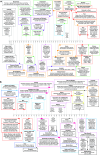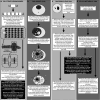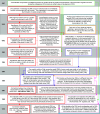A historical and evolutionary perspective on the biological significance of circulating DNA and extracellular vesicles
- PMID: 27652382
- PMCID: PMC11108302
- DOI: 10.1007/s00018-016-2370-3
A historical and evolutionary perspective on the biological significance of circulating DNA and extracellular vesicles
Abstract
The discovery of quantitative and qualitative differences of the circulating DNA (cirDNA) between healthy and diseased individuals inclined researchers to investigate these molecules as potential biomarkers for non-invasive diagnosis and prognosis of various pathologies. However, except for some prenatal tests, cirDNA analyses have not been readily translated to clinical practice due to a lack of knowledge regarding its composition, function, and biological and evolutionary origins. We believe that, to fully grasp the nature of cirDNA and the extracellular vesicles (EVs) and protein complexes with which it is associated, it is necessary to probe the early and badly neglected work that contributed to the discovery and development of these concepts. Accordingly, this review consists of a schematic summary of the major events that developed and integrated the concepts of heredity, genetic information, cirDNA, EVs, and protein complexes. CirDNA enters target cells and provokes a myriad of gene regulatory effects associated with the messaging functions of various natures, disease progression, somatic genome variation, and transgenerational inheritance. This challenges the traditional views on each of the former topics. All of these discoveries can be traced directly back to the iconic works of Darwin, Lamarck, and their followers. The history of cirDNA that has been revisited here is rich in information that should be considered in clinical practice, when designing new experiments, and should be very useful for generating an empirically up-to-date view of cirDNA and EVs. Furthermore, we hope that it will invite many flights of speculation and stimulate further inquiry into its biological and evolutionary origins.
Keywords: Genometastasis; Inheritance of acquired characteristics; Lateral gene transfer; Metabolic DNA; Pangenesis; Virtosomes.
Figures





References
-
- Avery OT, MacLeod CM, McCarty M. Studies on the chemical nature of the substance inducing transformation of pneumococcal types induction of transformation by a desoxyribonucleic acid fraction isolated from pneumococcus type III. J Exp Med. 1944;79:137–158. doi: 10.1084/jem.79.2.137. - DOI - PMC - PubMed
-
- Fleischhacker M, Schmidt B. Circulating nucleic acids (CNAs) and cancer—a survey. Biochim Biophys Acta. 2007;1775:181–232. - PubMed
-
- Mandel P, Métais P. Les acides nucléiques du plasma sanguin chez l’homme [The nucleic acids of blood plasma in humans] Compte Rendu de l’Academie des Sciences. 1948;142:241–243. - PubMed
Publication types
MeSH terms
Substances
LinkOut - more resources
Full Text Sources
Other Literature Sources

